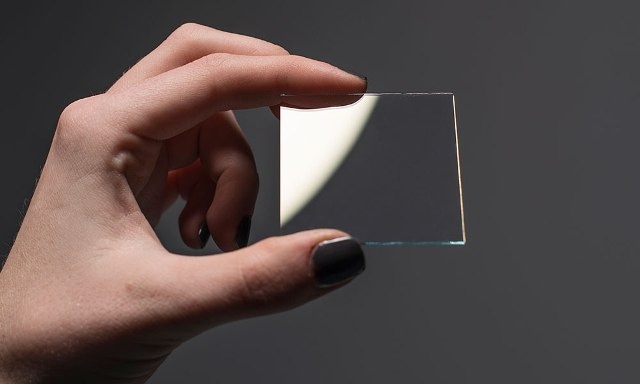May 3 2016
Photonics applications largely depend on nonlinear optics, which can be defined as the different way materials act based on the intensity of light that passes through them. The fact is that the more the nonlinearity, the more potential a material has for use in real-life applications.
 Indium tin oxide-coated glass. (CC BY-NC-SA 2.0 photo / Adafruit Industries)
Indium tin oxide-coated glass. (CC BY-NC-SA 2.0 photo / Adafruit Industries)
A team of researchers, headed by Robert W. Boyd, professor of physics and optics at the University of Rochester and the Canada Excellence Research Chair in Quantum Nonlinear Optics at the University of Ottawa, has demonstrated that indium tin oxide, a transparent, electrical conductor, has up to 100 times superior nonlinearity than any other known materials.
This result is a game-changer for photonics applications. It rests on the core of what I’ve worked on for over 30 years at Rochester. I find it very rewarding that even after all this time there are still fundamental questions to be answered in the field of nonlinear optics.
Robert W. Boyd, Professor of Physics and Optics, University of Rochester
The study’s findings were published online by the Science journal.
Light is used in photonics data transmission. It is also used in photonics to execute logical operations, similar to the way electronics uses electrons. In order to control light, a specific feature - the refractive index - of the material that is transmitting the light has to be controlled first.
Photonics applications can control light to travel faster or slower by modifying a material’s refractive index. A material is optically nonlinear when the refractive index is different for different light intensities. When pulse of light is transmitted via a material, the refractive index alters based on that intensity.
The material’s refractive index is altered only for a few femtoseconds. In some potential applications, it is possible to transmit a second pulse via the material before it can recover from the first pulse. The second pulse is then able to “see” the material as having the refractive index as altered by the first pulse. It is the material’s rapid recovery, as well as the range of values that the refractive index can take, that make this system principally attractive to photonics applications.
Boyd along with his PhD student at Ottawa, M. Zahirul Alam, and then-research associate Israel De Leon were able to develop the previous record for optical nonlinearities by a factor of 100. This advancement happened because the researchers utilized the remarkable optical properties of a material that occurs under specific conditions - the epsilon-near-zero region.
“It was surprising that showing such a strong optical nonlinearity in a known metal was this easy,” said Boyd. “This material has been around for many years, but until now the community had overlooked the potential that the ‘epsilon-near-zero’ region of materials offered.”
The optical nonlinear response that we have observed introduces a new paradigm in nonlinear optics. The common knowledge had always been that nonlinear effects are tiny compared with the linear ones; but in our work we have measured a nonlinear response that is 170% larger than the linear response.
Israel De Leon, Professor, Tecnologico de Monterrey
The outcome paves the way for more detailed research of this region of materials, with an aim to identify a material that can provide the precise properties for specific photonics applications.
The ‘epsilon-near-zero’ region for this material is connected to light of a certain frequency, about a wavelength of 1.2 µm. This wavelength is particularly important, as it is in between that of visible light and light of wavelength 1.5 µm, and has been shown to be useful in optical communications, which utilizes gadgets such as fiber optics to transmit data in light.
Alterations in the material’s chemical composition are likely to lead to an alteration in the frequency at which epsilon near zero happens, making this frequency closer to that applied in optical communications.